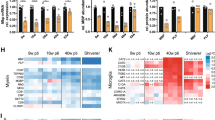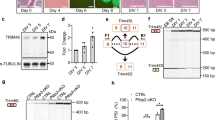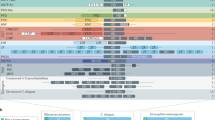Abstract
The mouse quaking gene, essential for nervous system myelination and survival of the early embryo has been positionally cloned. Its sequence implies that the locus encodes a multifunctional gene used in a specific set of developing tissues to unite signal transduction with some aspect of RNA metabolism. The quakingviable (qkv) mutation has one class of messages truncated by a deletion. An independent ENU-induced mutation has a nonconservative amino acid change in one of two newly identified domains that are conserved from the C. elegans gld-1 tumour suppressor gene to the human Src-associated protein Sam68. The size and conservation of the quaking gene family implies that the pathway defined by this mutation may have broad relevance for rapid conveyance of extracellular information directly to primary gene transcripts.
This is a preview of subscription content, access via your institution
Access options
Subscribe to this journal
Receive 12 print issues and online access
$209.00 per year
only $17.42 per issue
Buy this article
- Purchase on Springer Link
- Instant access to full article PDF
Prices may be subject to local taxes which are calculated during checkout
Similar content being viewed by others
References
Bennett, D. Developmental analysis of a mutation with pleiottopic effects in the mouse. J. Morph. 96, 199–234 (1956).
Sidman, R.L., Dickie, M.M. & Appel, S.H. Mutant mice (quaking and jimpy) with deficient myelination in the central nervous system. Science. 144, 309–311 (1964).
Friedrich, Jr V.L. The myelin deficit in quaking mice. Brain Res. 82, 168–172 (1974).
Bennett, W.J., Gall, A.M., Southard, J.L. & Sidman, R.L. Abnormal spermtogenesis in quaking, a myelin-deficient mutant mouse. Biol. Reprod. 5, 30–58 (1971).
Ebersole, T., Rho, O. & Artzt, K. The proximal end of mouse chromosome 17: New molecular markers identify a deletion associated with quakingviable. Genetics. 131, 183–190 (1992).
Bode, V.C. Ethylnitrosourea mutagenesis and the isolation of mutant alleles for specific genes located in the T region of mouse chromosome 17. Genetics 108, 457–470 (1984).
Justice, M.J. & Bode, V.C. Induction of new mutations in a mouse t-haplotype using ethylnttrosourea mutagenesis. Genet. Res. Camb. 47, 187–192 (1986).
Shedlovsky, A., King, T.R. & Dove, W.F. Saturation germ line mutagenesis of the murine t region including a lethal allele at the quaking locus. Proc. Natl. Acad. Sci. USA. 85, 180–184 (1988).
Justice, M.J. & Bode, V.C., ENU-induced alleles of the murine quaking locus are recessive embryonic lethal mutations. Genet. Res. Camb. 51, 95–102 (1988).
Gibson, T.J., Thompson, J.D. & Heringa, J. The KH domain occurs in a diverse set of RNA-binding proteins that include the antiterminator NusA and is probably involved in binding to nucleic acid. FEBS. 324, 361–366 (1993).
Siomi, H., Matunis, M.J., Michael, W.M. & Dreyfuss, G. The pre-mRNA binding K protein contains a novel evolutionary conserved motif. Nucl. Adds Res. 21, 1193–1198 (1993).
Burd, C.G. & Dreyfuss, G. Conserved structures and diversity of functions of RNA-blndingproteins. science 266, 615–621 (1994).
Wong, G. et al. Molecular cloning and nucleic acid binding properties of the GAP-associated Tyrosine Phosphoprotein p62. Cell 69, 551–558 (1992).
Fumagalli, S., Totty, N.F., Hsuan, J.J. & Courtneidge, S.A. A target for Src in mitosis. Nature 368, 871–874 (1994).
Taylor, S.J. & ShaJloway, D., RNA-bindlng protein associated with Src through its SH2 and SH3 domains in mitosis. Nature. 368, 867–871 (1994).
Ogawa, W., Hosomi, Y., Shii, K. & Roth, R.A. Evidence for two distinct 60-kilodalton substrates of the SRC tyrosine kinase. J. Biol. Chem. 289, 29602–29608 (1994).
Jones, A.R. & Schedl, T. Mutations in gld-1, a female germ cell-specific tumor suppressor gene in Caenorhabditis elegans, affect a conserved domain also found in Src-associated protein Sam68. Genes Devel. 9, 1491–1504 (1995).
Kiledjian, M. & Dreyfuss, G. Primary structure and binding activity of the hnRNP U protein: binding RNA through RGG box. EMBO J. 11, 2655–2664 (1992).
Yu, H. et al. Structural basis for the binding of proline-rich peptides to SH3 domains. Cell 76, 933–945 (1994).
Feng, S., Chen, J.K., Yu, H., Simon, J.A. & Schreiber, S.L. Two binding orientations for peptides to the Src SH3 domain: Development of a general model for SH3-llgand interactions. Science 266, 1241–1247 (1994).
Weng, Z. et al. Identification of Src, Fyn, and Lyn SHS-binding proteins: Implications for a function of SH3 domains. Mol. Cell. Biol. 14, 4509–4521 (1994).
Hobert, 0., JaJal, B., Schlessinger, J. & Ulrich, A. Novel signaling pathway suggested by SH3 domain-mediated p95vav/heterogeneous ribonucleoprotein K interaction. J. Biol. Chem. 269, 20225–20228 (1994).
Ashley, C.T. et al. Human and murine FMR-1: Alternative splicing and translational initiation downstream of the CGG-repeat. Nature Genet. 4, 244–251 (1994).
Siomi, H., Choi, M., Siomi, M.C., Nussbaum, R.L. & Dreyfuss, G. Essential role for KH domains in RNA binding: Impaired RNA binding by a mutation in the KH domain of FMR1 that causes fragile X syndrome. Cell 77, 33–39 (1994).
Timsit, S., Martinez, S., Allinquant, B., Peyron, F., Puelles, L. & Zalc, B. Oligodendrocytes originate in a restricted zone of the embryonic ventral neural tube defined by DM-20 mRNA expression. J. Neurosci. 15, 1012–1024 (1995).
Darnell, Jr J.E., Kerr, M. & Stark, G.R. Jak-STAT pathways and transcriptional activation in response to IFNs and other extracellular signaling proteins. Science. 264, 1415–1421 (1994).
Umemori, H., Sato, S., Yagi, T., Aizawa, S & Yamamoto, T. Initial events of myelination involve Fyn tyrosine kinase signalling. Nature 367, 572–576 (1994).
Richard, S. et al. Association of p62, a multifunctional SH2-binding and SH3-binding protein, with src family tyrosine kinases, Grb2, and phospholipase Cλ-1. Mol. Cell. Biol. 15, 186–197 (1995).
Hill, M.A., Schedlich, L. & Gunning, P. Serum-induced signal transduction determines the peripheral location of β-actin mRNA within the cell. J.Cell.Biol. 126, 1221–1230 (1994).
Steward, O. Dendrites as compartments for macromolecular synthesis. Proc. Natl. Acad. Sci. USA 91, 10766–10768 (1994).
Mayeda, A., Munroe, S.H., Cáceres, J.F. & Krainer, A.R. Function of conserved domains of hnRNP A1 and other hnRNP A/B proteins. EMBO J. 13, 5483–5495 (1994).
Fujita, N. et al. Developmentally regulated alternative splicing of brain myelin-associated glycoprotein mRNA is lacking in the quaking mouse. FEBS. 232, 323–327 (1988).
Fujita, N. et al. The large isoform of myelin-associated glycoprotein is scarcely expressed in the quaking mouse brain. J. Neurochem. 55, 1056–1059 (1990).
Campagnoni, A.T. et al. Structure and developmental regulation of Golli-mbp, a 105-kilobase gene that encompasses the myelin basic protein gene and is expressed in cells in the oligodendrocyte lineage in the brain. J. Biol. Chem. 268, 4930–4938 (1993).
Ikenaka, K., Kagawa, T. & Mikoshiba, K. Selective expression of DM-20, an alternatively spliced myelin proteolipid gene product, in developing nervous sytem of the mouse. J. Neurochem. 58, 2248–2253 (1992).
DeWille, J.W. & Farmer, S.J. Quaking phenotype influences brain lipid-related mRNA levels. Neurosci. Lett. 141, 195–198 (1992).
Crenshaw III, E.B., Russo, A.F., Swanson, L.W. & Rosenfeld, M.G. Neuron-specific alternative RNA processing in transgenic mice expressing a methallothionein-calcitonin fusion gene. Cell 49, 389–398 (1987).
Rossi, J.M. et al. Genomic analysis using a yeast artificial chromosome library with mouse DNA inserts. Proc. Natl. Acad. Sci. USA 89, 2456–2460 (1992).
Riley, J. et al. A novel, rapid method for the isolation of terminal sequences from yeast artificial chromosome (YAC) clones. Nucl. Acids Res. 18, 2887–2890 (1990).
Enrich, E., Craig, A., Poustka, A., Frischauf, A.-M. & Lehrach, H. A family of cosmid vectors with the multi-copy R6K replication origin. Gene 57, 229–237 (1987).
Wilkinson, D.G. Whole mount in situ hybridization of vertebrate embryos. In situ Hybridization, A Practical Approach (ed Wilkinson, D.G.) 75–83 (IRL Press, New York, 1992).
Yan, Y., Lagenaur, C. & Narayanan, V. Molecular cloning of M6: Identification of a PLP/DM20 gene family. Neuron. 11, 423–431 (1993).
Author information
Authors and Affiliations
Rights and permissions
About this article
Cite this article
Ebersole, T., Chen, Q., Justice, M. et al. The quaking gene product necessary in embryogenesis and myelination combines features of RNA binding and signal transduction proteins. Nat Genet 12, 260–265 (1996). https://doi.org/10.1038/ng0396-260
Received:
Accepted:
Issue Date:
DOI: https://doi.org/10.1038/ng0396-260



